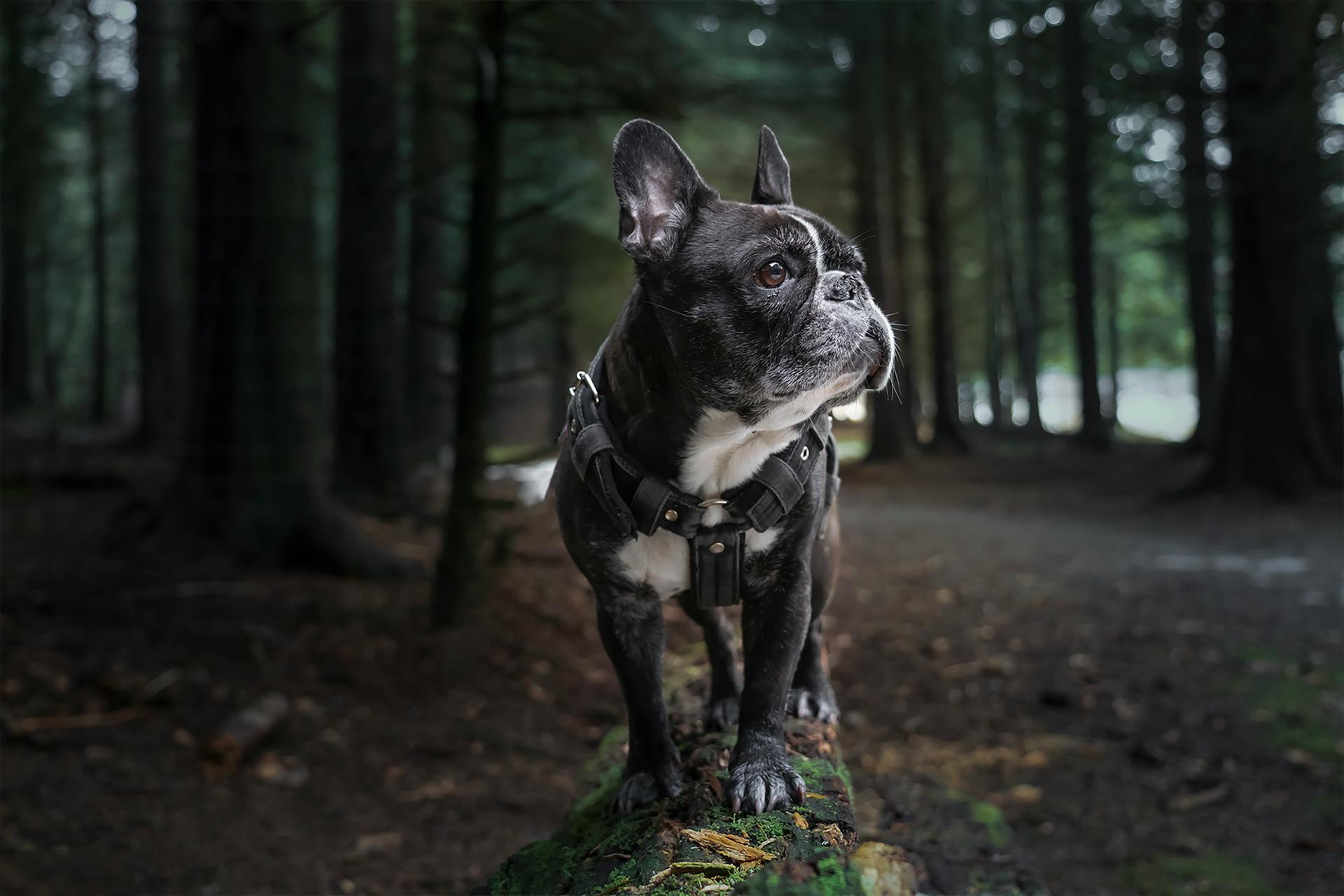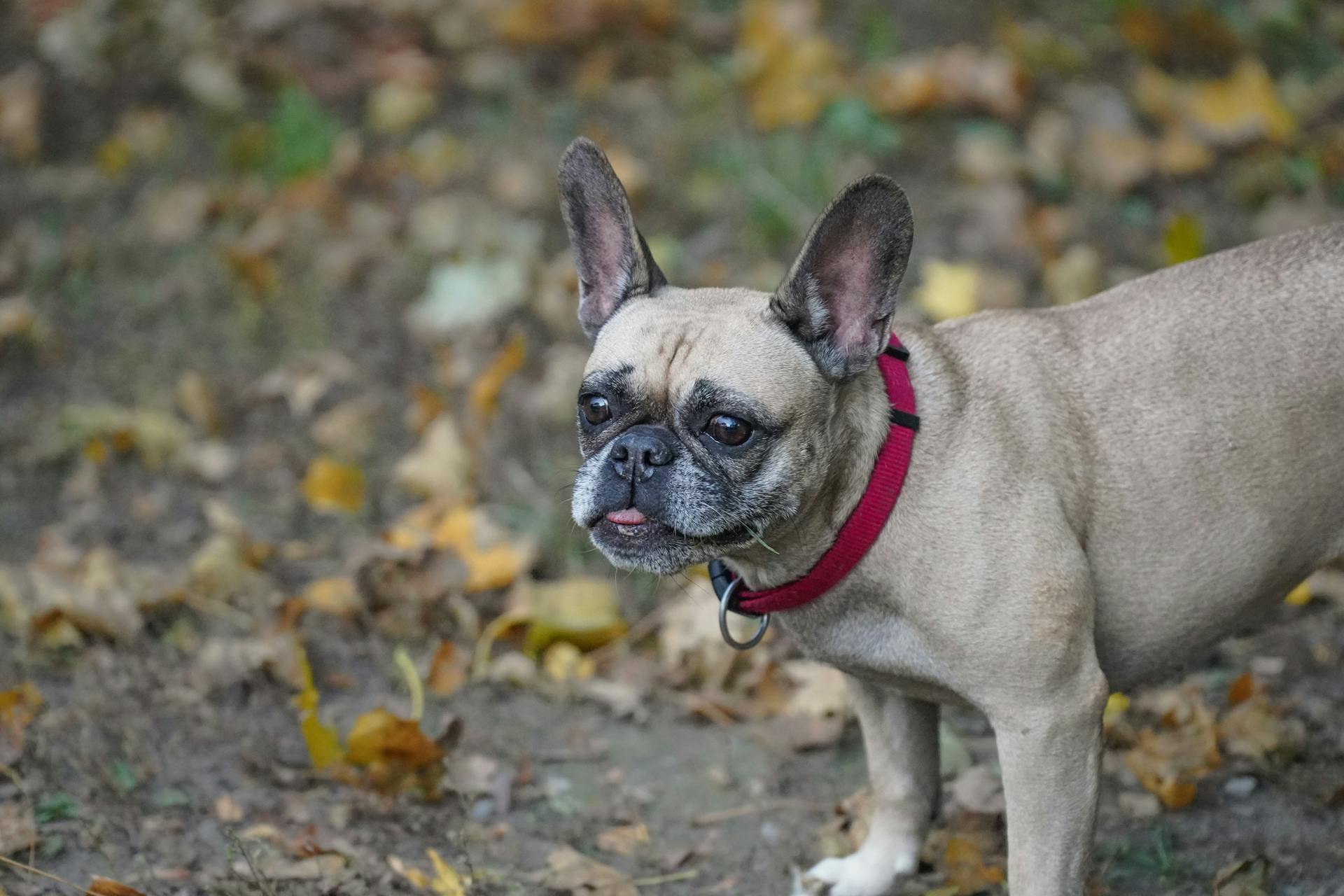
French Bulldogs and heat can be a deadly combination. French Bulldogs can easily overheat due to their flat face and short snout, which limits their ability to breathe and cool down.
Their body mass index (BMI) is also a significant factor, as French Bulldogs are prone to obesity, which can further exacerbate heat-related issues. In fact, studies have shown that French Bulldogs with a higher BMI are more likely to experience heat-related illnesses.
In hot weather, French Bulldogs can quickly become dehydrated, leading to serious health complications. It's essential to monitor their temperature and take steps to prevent heat-related illnesses.
On a similar theme: Shih Tzu Menstruation Symptoms
Why French Bulldogs Overheat
French Bulldogs are particularly vulnerable to heat stroke due to their brachycephalic facial structure, which makes it difficult for them to regulate their body temperature.
This unique face shape traps heat and prevents air from flowing freely into the lungs, causing a buildup of heat in the body.
Expand your knowledge: Heat and Dogs Not Eating
Summer is a challenging time for French Bulldog owners, as the hot weather poses a significant risk to their furry friends' health.
In fact, French Bulldogs are more prone to heat stroke than other breeds due to their short noses and flat faces.
Their body temperature can rise quickly, leading to serious health complications if left unchecked.
French Bulldogs can't sweat like humans do, which makes it even harder for them to regulate their body temperature in hot weather.
Consider reading: Is Cold Water Bad for Dogs in Hot Weather
Recognizing Heat Overload
If your Frenchie seems uncomfortable or you know it's a scorcher outside, skip outdoor activities and opt for indoor fun instead.
Excessive panting is a clear sign that your dog is overheating.
If you notice your Frenchie showing signs of heat stroke, such as excessive panting, drooling, or lethargy, act fast.
Move your pup to a cooler area immediately, whether it's a shady spot or indoors with air conditioning.
Cool water can be used to wet your dog's body, especially the back of the neck, underarms, and belly.
For more insights, see: Dog Food for French Bulldogs with Allergies
Don't force your dog to drink, but instead allow them to take sips if they're willing.
Focus on cooling the neck, back, and legs when using cool water.
Avoid submerging your dog in cold water, as it can lead to shock.
Here are some key signs to look out for to determine if your Frenchie is experiencing heat overload:
If your Frenchie shows severe symptoms of overheating, such as collapse, seizures, or excessive vomiting, seek immediate veterinary care.
13 Tips to Prevent
Summer is a great time to be outdoors with your French Bulldog, but it's essential to take precautions to prevent heat strokes. Recognize when it's too hot for your Frenchie, and skip outdoor activities if they seem uncomfortable or it's a scorcher outside.
One of the best tips is to use cooling items for French Bulldogs. Special heat-resistant fabrics can provide immediate heat relief when worn wet, making them a must-have item in your dog's closet.
Here's an interesting read: English Bulldog Heat Cycle
Limit outdoor time on extremely hot days, and avoid strenuous exercise during the hottest part of the day. Gentle exercise or playtime indoors is a better option, with plenty of water and frequent breaks to rest in the shade.
Monitor humidity levels, as high humidity can make it harder for your Frenchie to breathe. Keep them in air-conditioned spaces during the muggiest parts of the day.
Keep exercise to cooler parts of the day, such as early morning or late evening, when the sun is less intense and temperatures are cooler. This is especially important for older or health-compromised French Bulldogs.
Here's a quick rundown of the top tips to prevent heat strokes:
- Recognize when it's too hot for your Frenchie
- Use cooling items, such as heat-resistant vests
- Limit outdoor time on extremely hot days
- Avoid strenuous exercise during the hottest part of the day
- Monitor humidity levels
- Keep exercise to cooler parts of the day
Use Cooling Vests
Cooling vests are a game-changer for French Bulldogs during hot weather. They're specially designed to regulate body temperature and can be very effective in preventing heat exhaustion.
You can use a cooling jacket for French bulldogs or a Frenchie cooling vest to help keep them cool. These vests work by pulling heat away from your pup's body, providing instant relief from the heat.
Some days are just too hot for your Frenchie to handle, so it's best to keep them indoors where it's cool and safe. On those scorchers, consider using a cooling vest to help regulate their body temperature.
Here are some things to look for when choosing a cooling vest for your French Bulldog:
- Look for vests made from breathable, moisture-wicking materials that will help keep your pup cool and dry.
- Consider vests with built-in cooling technology, such as phase-change materials or evaporative cooling systems.
- Choose a vest that's designed specifically for French Bulldogs, taking into account their unique body shape and size.
Hydration and Nutrition
Hydration is key for French Bulldogs in the summer, and it's essential to provide access to fresh, cool water at all times. Always have a ready-to-use travel water bottle, like the "ANPETBEST Dog Water Bottle", on hand for walks or trips.
Make sure to check your Frenchie's temperature regularly, aiming for a rectal temperature of about 103°F (39.4°C) to indicate the immediate danger has passed. Overdrinking can lead to vomiting, so offer small sips of cool water instead of forcing them to drink.
Fresh water with ice cubes is a great way to keep your dog hydrated, and you can also provide frozen treats like ice cubes made with low-sodium chicken broth. Always err on the side of caution and seek vet intervention if you suspect heat stroke, even if your Frenchie seems to be cooling down.
Hydration Is Key
Hydration is key for your Frenchie, especially in the summer. Make sure to provide access to fresh, cool water at all times.
Always have a ready-to-use travel water bottle for your pet, like the ANPETBEST Dog Water Bottle. This will keep your Frenchie hydrated on walks or trips.
Fresh water should always be available to your dog. Consider adding ice cubes to their water bowl to keep it cooler for longer.
Frozen treats, such as ice cubes made with low-sodium chicken broth, can also be a great way to keep your Frenchie hydrated.
Always err on the side of caution and provide plenty of water, as overdrinking can lead to vomiting, which isn't something you want to deal with on top of heat stroke.
Remember, if you suspect heat stroke at all, it's time to go to the vet. Even if your Frenchie seems to be cooling down and feeling better, heat stroke can have delayed effects, some of which could be fatal.
When to Spay My Pet
Spaying your pet is a crucial decision that affects their health and well-being. It's essential to consider the timing of spaying, as it can impact your pet's development and prevent certain health issues.
Spaying should be done before the first heat cycle, which typically occurs between six to nine months of age. This is especially true for breeds like Bulldogs, which can be prone to certain health problems if spayed too late.
Spaying too early, on the other hand, can lead to risks such as certain cancers and joint problems. It's essential to weigh these risks against the benefits of spaying, such as preventing unwanted litters and reducing the risk of certain health issues.
Here are some key considerations to keep in mind when deciding when to spay your pet:
Ultimately, the decision of when to spay your pet should be made in consultation with a veterinarian, who can provide personalized advice based on your pet's specific needs and circumstances.
Sources
- https://frenchiespace.shop/french-bulldog-heat-stroke-13-best-tips/
- https://pudgybulls.com/how-long-can-french-bulldogs-be-outside-in-the-heat/
- https://www.northcalfrenchies.com/post/10-ways-how-to-keep-french-bulldogs-cool-and-prevent-overheating
- https://lepepitefrenchies.com/keeping-your-french-bulldog-cool-in-the-summer-heat/
- https://vet4bulldog.com/question/french-bulldog-first-heat-and-estrus-cycle/
Featured Images: pexels.com


